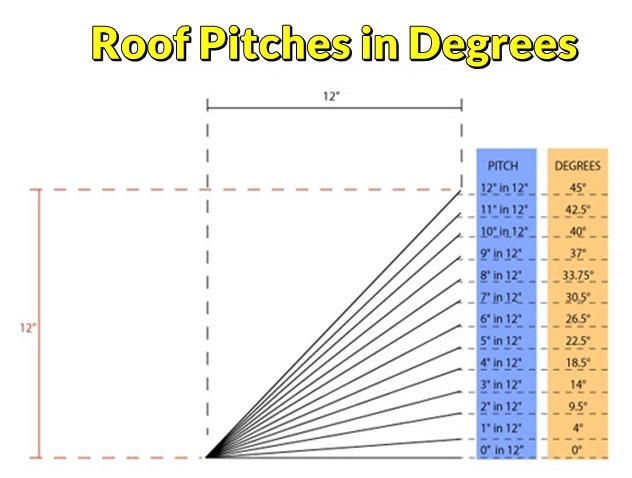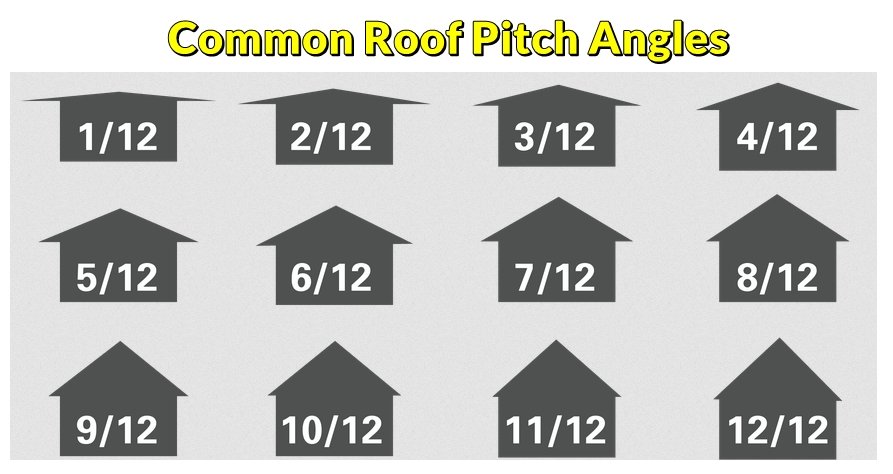Roof slope is an important aspect to consider when discussing roof pitches. We know that a lot of roofs are either pitched or flat roofs. We know that a lot of roofs are either pitched or flat. When it is a flat one, zero degrees of inclination are involved here.
When the roof is pitched, a certain degree is formed there. This is what they call roof pitches. Roof pitches are expressed in either degrees or a fraction.
Read also: The Most Common Roof Pitch to Use for Houses
Common Roof Pitches in Degrees
Standard roofs have a certain degree of inclination in them, typically determined by the roof’s rise and run. These measurements dictate the degree of incline. The rise refers to the vertical increase from the base of the roof to its peak, and the run indicates the horizontal distance across the roof.
Using a tape measure, builders calculate these dimensions to establish the roof’s angle.

- Rise is defined as the vertical height of a roof. In the Cartesian coordinate system, rise is analogous to the Y-axis.
- Span is defined as the horizontal length of a roof. That said, the length should be measured perpendicularly. This is similar to the X-axis in the Cartesian coordinate system. However, remember that the span only takes half of the horizontal measurement of the roof.
The inclination degree of a roof is also called roof angle. Roof pitches are measured using a trigonometrical formula from the ratio between its rise and span. For standard pitch charts, people typically use the fraction-type graph.
The chart offers a variety of roof pitches, ranging from 0/12 to 12/12, where each number represents the ratio of rise to span. On steeper slopes, such as 12 pitch, the angle increases significantly, impacting the roofing structure’s aesthetic and functional aspects.
Sometimes, pitches can extend to 15/12 or even 18/12, allowing for greater internal space under the roof.
Read also: Joining two roofs with different pitches
For example, if the roof pitch is 8/12, the height can be 400 cm while the span is 600 cm. That said, the span takes over only half of the horizontal length of the roof. If counted using the trigonometry formula, this 8/12 roof has a 33.69 angle in degrees.

What is the range of roof pitch degrees from 0/12 to 12/12? Counted using the formula, you can see that the inclination degree ranges from 0o-45o for the roof inclination. For further explanation, each roof pitch has this pitch of a roof degree as follows:
- 1/12 = 4.76o
- 2/12 = 9.46 o
- 3/12 = 14.04 o
- 4/12 = 18.43o
- 5/12 = 22.62 o
- 6/12 = 26.57 o
- 7/12 = 30.26 o
- 8/12 = 33.69 o
- 9/12 = 36.87 o
- 10/12 = 39.81o
- 11/12 = 42.51o
- 12/12 = 45.00o
The pitch calculations are vital for ensuring structural integrity and proper roof drainage in roofing.
Read also: What is Purlin Span for Metal Roof ?
When dividing the pitch of a roof, builders consider the roofing material to be used, as certain materials are better suited for steeper slopes. A steep slope typically requires more durable materials to handle potential water run-off and the stress of heavy weather conditions.
Understanding these factors is crucial in choosing the right materials and ensuring the longevity of the roof.
Common Roof Pitch Angles Used by Builders
According to sources, builders’ standard roof pitch is around 4/12 to 9/12; when measured in degrees, it will be around 18.43o –36.87o.

You may wonder why determining the roof pitches is essential in making the roof. Several reasons become necessary to detail it before making the rafters and other aspects related to roof-building.
Pitch calculations are essential for builders to calculate roof pitch accurately. This helps determine the type and size of materials that will be used. Additionally, understanding how to convert roof pitch to degrees is crucial for ensuring the functionality and durability of the roof.
Initially, determining the roof pitch aids builders in selecting the appropriate type and size of roofing material, which is crucial for estimating durability and functionality. If the roof needs to accommodate appliances or other elements, knowing the pitch in degrees ensures sufficient space is available, enhancing the overall utility of the roofing system.


